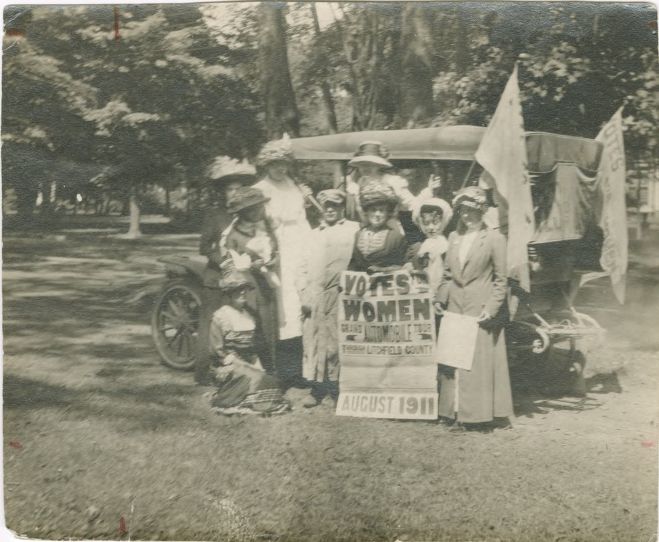Suffragists Hit the Road to Norfolk
by Andra Moss

Something special was in the air in August 1911. It was the sound of women’s voices rising, once again, to demand their right to vote. Decades of unsuccessful advocacy for women’s suffrage in Connecticut had left many discouraged at the turn of the 20th century, but by 1911 fresh winds were blowing. The Connecticut Woman Suffrage Association (CWSA), formed in 1869, had new, energetic leadership, and they were urging supporters to keep up the pressure on the Connecticut General Assembly to ratify the 19th Amendment. On July 29, 1911, Norfolk responded, founding the Norfolk branch of the CWSA. Amelia (Minna) Scranton Taylor, wife of prominent local architect Alfredo Taylor, was elected the group’s president.
Within weeks, Mrs. Taylor and her Norfolk troops would join in the CSWA’s month-long “Grand Automobile Tour” of Litchfield County, known to be something of an anti-suffrage stronghold. The inventive car campaign began in New Haven on August 1 and ended in Torrington on August 31, stopping for rallies and speeches in 32 communities throughout the county. Norfolk hosted one of their final events, on August 22nd.
The Hartford Courant struck a tone of concern about this effort in its article of July 27 beneath the headline “Will Besiege Litchfield County”:
“The activity of the Connecticut suffragists is taking a new form. The month of August is to see a suffrage campaign which will embrace the whole of Litchfield County. The quiet tree-lined streets of highly respectable and long settled towns…are to be invaded by automobiles carrying parties of women led by Miss Emily Pierson, the state organizer of the Connecticut Woman Suffrage Association, and reinforced by speakers.”
However, The Bridgeport Times and Evening Farmer was triumphant in its support, recording a splendid evening’s event in Norfolk on August 22, 1911, organized by Minna Taylor:
“It was the people of Norfolk—a full, representative audience—that gathered in the Eldridge Gymnasium on Tuesday evening to hear Mrs. Rheta Childe Dorr, and Rev. Anna Howard Shaw plead for votes for women. Mrs. Dorr put before her hearers the case of the working women, who, weaker, less well-trained and traditionally cheaper than the men, are further handicapped by being deprived of the protection of the franchise. Dr. Shaw, the veteran leader of the suffragists of the United States, spoke of the need of the vote for the women in the home…as she has no say in the government of the city, state or nation.
Norfolk was friendly territory for the suffrage league, for just recently a suffrage league under the presidency of Mrs. A. E. Scranton Taylor has been organized there. This league, which counts among its members many of the most important men and women of the town, gave a warm welcome to Miss Pierson and her band of campaigners, and the meeting there was one of the most successful of the tour.
One man who when first asked to go to the meeting growled out: “what for should I be going to a thing like that?” after he had yielded…and had listened to the pleadings of the suffragettes, bought no less than four [suffrage] buttons and was seen leaving the meeting with every one of them in plain evidence on his coat and hat.”
The history of the fight for women’s suffrage in Norfolk is the focus of a new exhibit at the Norfolk Historical Society. It follows town activism on women’s voting rights, both ‘pro’, such as Minna Taylor and male supporters including her husband, and ‘anti’, such as town patrons Mary and Isabella Eldridge.
When at last the fight was won in 1920 with the ratification of the 19th Amendment to the U.S. Constitution, 201 Norfolk women registered to vote. Curator Ann Havemeyer cross-referenced their names against the 1920 U.S. Census to learn more about these women, creating a breakdown by age, profession and other details for the exhibit. “Something so interesting about this list,” remarks Havemeyer, “is that it shows the socio-economic breakdown of Norfolk.” First-time voters included summer residents who were still in Norfolk; housekeepers; school teachers; and wives of bankers and lawyers, farmers and builders. There, too, were the names of Grace Smith, 58, an African-American woman, and Margaret Bowe, 37, maid to Mary Eldridge (who did eventually give in to the inevitable and register, as well).
Pride of place at the top of the list goes to Ella Converse, widow of a Norfolk farmer, who at age 87 registered to have her voice officially heard on matters concerning her country.
“From Solitude to Sisterhood: Norfolk Women and the Vote” is now on exhibit at the Norfolk Historical Society, 13 Village Green. The museum is open every weekend from 1 p.m. to 4 p.m. through Columbus Day.
